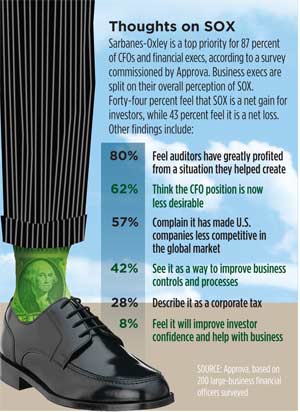Columns
Bits and Bytes
- By ADT Staff
- September 1, 2005
NEW TECH
 Softimage, a subsidiary of Avid Technology, has been showing off its Face Robot
software, which allows 3-D artists to create lifelike facial animation for high-end
film, post and games projects. The technology is built on a computer model of
facial soft tissue that mimics the full range of emotions portrayed by the human
face. The software supports keyframe animation and motion capture, the primary
techniques used for digital acting. The soft-tissue model at the core of the
technology removes the need to manually create dozens or even hundreds of 3-D
shapes for different facial expressions.
Softimage, a subsidiary of Avid Technology, has been showing off its Face Robot
software, which allows 3-D artists to create lifelike facial animation for high-end
film, post and games projects. The technology is built on a computer model of
facial soft tissue that mimics the full range of emotions portrayed by the human
face. The software supports keyframe animation and motion capture, the primary
techniques used for digital acting. The soft-tissue model at the core of the
technology removes the need to manually create dozens or even hundreds of 3-D
shapes for different facial expressions. |
10 YEARS AGO
In the September 1995 issue of ADT, editor John Desmond shared a clever t-shirt
slogan he saw at a Microsoft Developer Division event: “Who says
Microsoft can’t spell ‘entirprize?’”
On the eve of the Windows 95 release, Desmond believed the joke to be revealing.
“Microsoft’s approach to scaling up to the enterprise is to redefine
the enterprise… Naturally, the enterprise redefined to the Microsoft vision
would call for the use of more Microsoft software.”
In Practitioner’s Perspective, Philip Herbst’s idea on
how to gain respect for I/S—outsource it. “Simply by introducing
some competition, management forces I/S to be more responsive and less elite.”
He goes on to describe this motivating tactic as the “fear of being hanged
in the morning.”
Tops in Trends features a prediction by Geoff Roach, director of product marketing
for Informix, on the future of the tools market. “Currently, more
than 300 companies sell development tools. That number is simply too high for
the market to support. In a couple years, there may be only 10 significant
players in the tools market, and at least three of them will be DBMS suppliers.”
LEFT/RIGHT BRAIN
Deterministic chaos, a mathematical property that drives complex systems such
as weather, may be the same principle that governs computer microchips.
The National Research Institute for Information and Automation in Orsay, France,
ran a standard program on a simulator used to design and test microprocessors.
They found discrepancies in the time it took to complete the task from one run
to the next.
Within the irregularities, the researches discovered a pattern, the mathematical
signature of deterministic chaos.
Researchers explained that complex systems such as microprocessors, which can
contain more than 400 million transistors, are not models of deterministic precision.
They are extremely sensitive, with slight fluctuations that lead to radical
changes over time.
INSECURITY
While some never forget a face, U.K. researchers are developing a biometric recognition
system that makes it possible to never forget an ear.
Ear-shape analysis may soon surpass face recognition as a means of identification.
Initial small-scale studies found the method to be 99.2 percent accurate. Researcher
Mark Nixon believes this due to the consistency of the ear. Unlike faces, it
does not change shape with expression or age.
So what about long locks blocking the ear? Nixon admits that it is an issue,
but adds that infrared technology may be used in the future to see through shaggy
hair.
THOSE WACKY USERS
According to a new survey by America Online and Salary.com, the average worker
admits to frittering away 2.09 hours per 8-hour workday, not including lunch
and scheduled break time. As a matter of practice, companies assume a certain
amount of wasted time when determining employee pay. However, the America Online/Salary.com
survey indicates employees are wasting about twice as much time as their employers
expect. Salary.com calculated that employers spend $759 billion per year on
salaries for which real work was expected, but not actually performed.
The biggest distraction for respondents? Personal Internet use—44.7 percent
of more than 10,000 people polled cited Web surfing as their number-one distraction
at work. Socializing with co-workers came in second at 23.4 percent. Conducting
personal business, “spacing out,” running errands and making personal
phone calls were the other popular time-wasting activities in the workplace.
Employees say they’re not always to blame for this wasted time, however.
About 33 percent of respondents cited lack of work as their biggest reason for
wasting time. About 23 percent said they wasted time at work because they feel
as if they are underpaid.
The average yearly American salary is $39,795 per year, $19.13 per hour. If
the average worker wastes 1.15 hours more than employers suspect, per 8-hour
work day, that adds up to $5,720 per year, per worker in wasted salary dollars.
So with the American workforce 132 million (non-farm) employees strong, the
total in lost salary dollars adds up to $759 billion per year.
Surfing and socializing are business as usual |
| Top Time-Wasting Activities (%) |
| 1 Surfing Internet (personal use) |
44.7% |
| 2 Socializing with co-workers |
23.4% |
| 3 Conducting personal business |
6.8% |
| 4 Spacing out |
3.9% |
| 5 Running errands off-premises |
3.1% |
| 6 Making personal phone calls |
2.3% |
| 7 Applying for other jobs |
1.3% |
| 8 Planning personal events |
1.0% |
| 9 Arriving late/Leaving early |
1.0% |
| 10 Other |
12.5% |
| Source: America Online and Salary.com |
NET WORK
The Internet Corporation for Assigned Names and Numbers, or ICANN, the Internet’s
key oversight agency, has authorized Iraq’s telecommunications regulators
to manage and assign Internet addresses ending in .iq.
The suffix had been in limbo following a 2002 federal indictment of the previous
managers, InfoCom. The computer and Web service company was allegedly funneling
money to Hamas, an Islamic extremist group.
The resolution, approved unanimously, simply states, “ICANN has reviewed
the request and has determined that the proposed re-delegation would be in the
best interests of the local and global Internet communities.”
U.S. and Iraqi officials had urged ICANN to free up .iq shortly after the U.S.
invasion, but the board resisted, citing uncertainty about Iraq’s stability.
FAR OUT
The University of Canterbury’s Department of Physics and Astronomy recently
developed two nanopatterning technologies for fabricating tiny electronic devices.
The first technology produces patterns in any shape; to prove the concept, university
researchers fabricated a map of New Zealand that is more than 1,000 times smaller
than the thickness of a human hair. This technology is a new variation used
by semiconductor companies to produce computer chips, and eliminates one of
the steps for lithography, researchers say.
The other technology improves stenciling for clusters, a process similar to
spray painting. The technology sprays clusters that won’t stick to the
stencil, eliminating clogging and creating very narrow wires.
BUY THE NUMBERS
Gartner forecasts the sales for application acceleration products will hit $1.5
billion this year, a 33-percent increase over 2004. The research firm predicts
the application acceleration market will reach $2.3 billion by 2009.
Application acceleration appliances consolidate server and data centers and
deploy browser-based application interfaces, helping deliver apps across local
and wide-area networks. The market features two segments: application delivery
controllers and WAN optimization controllers.
Cisco Systems topped the worldwide ADC market in the first quarter of 2005,
but lost market share since the fourth quarter of 2004, a loss Gartner attributes
to its dependence on outdated Layer 4 to Layer 7 switches.
Meanwhile, the WOC market stayed competitive in the first quarter of 2005,
with Network Appliance, Packeteer and Stratacache leading the way. Cisco, Citrix
Systems and Juniper Networks recently entered this market, amping up the competition.
FACT MATTER
 |
NOTHING BUT NET
iSkoot, a mobile Internet phone company, has introduced software that enables
mobile phone users to make and receive calls using Skype’s VoIP service.
The software does not require any special hardware, or a custom phone, or a
Wi-Fi hot spot.
The software automatically forwards Internet phone calls from a user’s
PC to any phone, including any cell phone; calls a buddy’s PC from any
phone; and switches an Internet phone call from a PC to any phone without disconnecting.
You can download a free 30-day trial version at iSkoot.
If you decide to keep it, you can pay a one-time $9.95 fee for unlimited use.
PROBLEM SOLVING
Need to know more about deploying wireless enterprise apps? 3G Americas released
a free whitepaper, “Enterprise Applications: Key Considerations for Selecting
and Deploying Wireless Corporate Applications,” it says was written to
help IT managers make sense of wireless security, integrated architecture and
the needs of end users. The whitepaper is a free download at www.3gamericas.org.
HYPE METER
Here’s a press release that pegged the needle on our Hype Meter:
BEIJING, Aug. 10 /Xinhua-PRNewswire/—President Hu Jintao attended the
60th anniversary marking the victory of the World War II (Russia’s Great
Patriotic War) in Moscow. He spared his time to meet with Russian World War
II veterans, who took part in the War of Resistance against Japan in Northeast
China in the 1940s. During their meeting, President Hu Jintao presented 30 sets
of 42-inch Hisense LCD TVs to the Russian veterans and friends.
It is reported that the General Office of the State Council and the Ministry
of Information Industry have made careful consideration on the gifts for Russia.
Then they decided to choose Hisense 4277 LCD TVs as the country’s gift.
After receiving the notice, Hisense Electronics took immediate action and finished
the TV production perfectly and efficiently. Having Hisense hi-tech TVs chosen
as the country’s gift shows the recognition of the high technology and
good quality of the TVs by both the country and the society.
COCKPIT ERROR
Be careful driving—hackers may tell you to stop riding their bumpers. Linux
hackers created Car Whisperer, software that records audio signals from passing
cars with unprotected hands-free Bluetooth systems. The Trifinite Group, a bunch
of European wireless security experts, demonstrated how hackers eavesdrop on
motorists using a directional antenna and a Linux laptop running Car Whisperer.
Many hands-free systems use standard Bluetooth four-digit security keys. Many
car manufacturers use the same code for all of their Bluetooth systems, allowing
hackers using Car Whisperer to transmit fake traffic announcements or eavesdrop
on conversations inside cars.